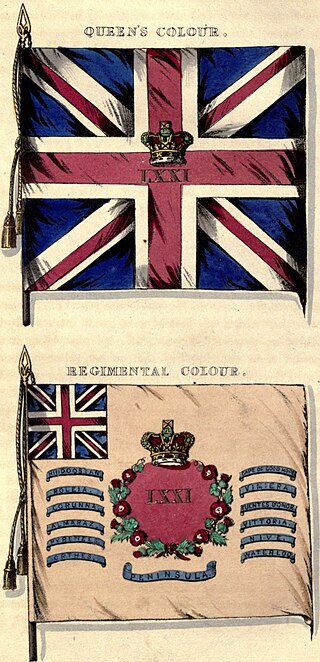
The Duke of Wellington's Regiment (West Riding) was a line infantry regiment of the British Army, forming part of the King's Division.

The 1st Rhode Island Regiment was a regiment in the Continental Army raised in Rhode Island during the American Revolutionary War (1775–83). It was one of the few units in the Continental Army to serve through the entire war, from the siege of Boston to the disbanding of the Continental Army on November 3, 1783.

The 84th Regiment of Foot (Royal Highland Emigrants) was a British regiment in the American Revolutionary War that was raised to defend present day Ontario, Quebec and Atlantic Canada from the constant land and sea attacks by American Revolutionaries. The 84th Regiment was also involved in offensive action in the Thirteen Colonies; including North Carolina, South Carolina, Georgia, Virginia and what is now Maine, as well as raids upon Lake Champlain and the Mohawk Valley. The regiment consisted of 2,000 men in twenty companies. The 84th Regiment was raised from Scottish soldiers who had served in the Seven Years' War and stayed in North America. As a result, the 84th Regiment had one of the oldest and most experienced officer corps of any regiment in North America. The Scottish Highland regiments were a key element of the British Army in the American Revolution. The 84th Regiment was clothed, armed and accoutred the same as the Black Watch, with Lieutenant Colonel Allan Maclean commanding the first battalion and Major General John Small of Strathardle commanding the second. The two Battalions operated independently of each other and saw little action together.

The New Hampshire Line was a formation in the Continental Army. The term "New Hampshire Line" referred to the quota of numbered infantry regiments assigned to New Hampshire at various times by the Continental Congress. These, along with similar contingents from the other twelve states, formed the Continental Line. For the promotion of senior officials, this concept is particularly important. Officers of the Continental Army below the rank of brigadier general were ordinarily ineligible for promotion except in the line of their own state.

The 72nd Highlanders was a British Army Highland Infantry Regiment of the Line. Raised in 1778, it was originally numbered 78th, before being redesignated the 72nd in 1786. Under the Childers Reforms it amalgamated with the 78th (Highlanders) Regiment to form the 1st Battalion of the Seaforth Highlanders in 1881.

The 71st Regiment of Foot was a Highland regiment in the British Army, raised in 1777. Under the Childers Reforms it amalgamated with the 74th (Highland) Regiment of Foot to become the 1st Battalion, Highland Light Infantry in 1881.

Lieutenant Colonel John Maitland was a British Marine and Army officer and politician who sat in the House of Commons between 1774 and 1779.

Lieutenant-Colonel John Campbell, of Stonefield (1753–1784) was a Scottish soldier known for his defence of Mangalore.
The 71st Regiment of Foot was a British Army regiment of infantry raised in 1775, during the American Revolutionary War and unofficially known as Fraser's Highlanders. It was disbanded in 1786.

Sir Allan Maclean, 6th Baronet of Morvern was the 22nd Clan Chief of Clan Maclean from 1750 till his death in 1783. He was the 4th Laird of Brolas. He died without leaving a male heir to his title, so the title was bestowed on his closest living male relative, a fourth cousin, Sir Hector Maclean, 7th Baronet.

Allan Maclean of Torloisk (1725–1798) was a Jacobite who became a British Army general. He was born on the Isle of Mull, Scotland. He is best known for leading the 84th Regiment of Foot in the Battle of Quebec.
General John Campbell, 17th Chief of MacArthur Campbells of Strachur was a Scottish soldier and nobleman, who commanded the British forces at the Siege of Pensacola, and succeeded Guy Carleton, 1st Baron Dorchester as Commander-in-Chief in North America in 1783 following the end of the American War of Independence.
The 74th Regiment of (Highland) Foot or 74th Regiment of Foot (Argylshire Highlanders) was a British Army line infantry regiment from 1777 to 1784 which was raised to fight in the American Revolutionary War.
The plan of raising a fencible corps in the Highlands was first proposed and carried into effect by William Pitt the Elder, in the year 1759. During the three preceding years, both the fleets and armies of Great Britain had suffered reverses, and it was thought that a "home guard" was necessary as a bulwark against invasion.
John Sinclair, 11th Earl of Caithness was a Scottish noble, Earl of Caithness and chief of the Clan Sinclair, a Highland Scottish clan.
Thomas Hunt (1754—1808) was an American military officer who served in the Continental Army during the American Revolutionary War and later served in the United States Army where he rose to the rank of colonel and served until his death.
The 80th Regiment of Foot (Royal Edinburgh Volunteers) was a regiment in the British Army from 1778 to 1783.
The Edenton District Brigade was an administrative division of the North Carolina militia during the American Revolutionary War (1776–1783). This unit was established by the North Carolina Provincial Congress on May 4, 1776, and disbanded at the end of the war.









